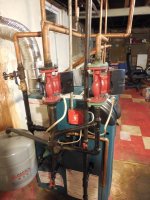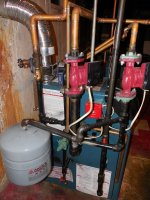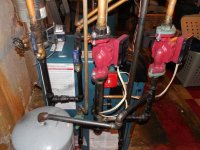Fer sher- Stevie Wonder probably doesn't even have a plumbing license!

I'll let BadgerBoilerMN spell it out for you in better detail, if he has the time.
What's immediately obvious to this unlicensed practitioner is that the expansion tank needs to be between the boiler and the input side of both pumps, and not hanging out on some long branch of plumbing, so that it can work as the high-frequency shock absorber for the pump impellers, reducing cavitation.
Also, hanging the expansion tank out on plumbing like that without support will also surely cause a catastrophic failure/leak at some point due to the long moment-arm of the plumbing stressing the tee and the vibe from the pumps inducing metal fatigue. This isn't a matter of if, but of when.
As-configured the pump on the left in the pictures is getting ZERO benefit of the expansion tank, and the pump the right is getting maybe 10% of what it would be getting if expansion tank were hanging on a tee (or better yet, on an air-scoop) on a straight section of fat pipe between the boiler and pumping manifold rather than at the long end of some isolated branch.
Download
the manual, and pay attention to both the details in section 6/p.12, and in Figure DW3 / p.47 in Appendix D.



